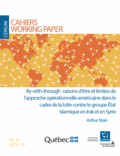Cahier du CÉRIUM no 31, 2023-10
Arthur Stein, chargé de recherche responsable du Moyen-Orient, Centre d'études et de relations internationales de l'Université de Montréal
Résumé
Ce Cahier du CÉRIUM examine l’approche « by-with-through » employée par les États-Unis dans le cadre de la lutte contre l’État islamique en Irak et en Syrie à partir de 2014. Ce modèle privilégiant le soutien à des forces locales chargées de la majeure partie des combats à un déploiement massif de troupes nationales semble répondre aux échecs des interventions américaines au Moyen-Orient et en Asie centrale du début des années 2000. L’article introduit ce mode d’action à faible empreinte, son application lors de l’engagement contre l’EI, et les raisons pouvant expliquer son usage par les États-Unis. L’analyse se penche ensuite sur les limites inhérentes à cette manière indirecte de mener la guerre ; que ce soit d’un point de vue éthique ou opérationnel. La conclusion ouvre finalement une réflexion sur l’avenir du modèle dans le cadre d’un système international tendant de plus en plus vers la bipolarité.
Abstract
This CÉRIUM report examines the “by-with-through” approach employed by the United States in the fight against the Islamic State in Iraq and Syria starting in 2014. This model, prioritizing support to local forces in charge of the bulk of ground combat over a massive deployment of national troops, appears to be a response to the failures of American interventions in the Middle East and Central Asia in the early 2000s. The article introduces this “light footprint” mode of action, its application in the battle against ISIS, and explores the reasons that may explain its use by the United States. The analysis then delves into the inherent limitations of this indirect way of conducting warfare, whether from an ethical or operational standpoint. The conclusion finally opens a reflection on the future of this model in the context of an international system increasingly tending toward bipolarity.

